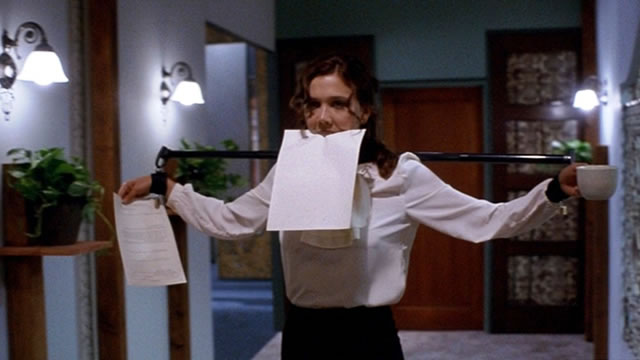
Secretary (2002) has taken up a disproportionate amount of time in researching and writing The Celluloid Dungeon. I already knew there were a lot of differences between Mary Gaitskill’s original short story and the finished film directed by Steven Shainberg, but I’ve since learned there were significant differences between Erin Cressida Wilson’s script and the finished product. (See Ariel Schudson’s “Secretary and Adaptation: the Telephone theory”) Thanks to inter-library loan, I’ve borrowed a copy of the script book, which also includes essays by Wilson and others.
The film largely follows the script’s story, but there are a number of subplots, characters and other elements that didn’t make it to the screen. One change was that when Peter tries to force Lee out of her vigil in Mr. Grey’s office, he deliberately hits her in the face. (Pg.99) Making Peter too gentle to ever do this in the film is an improvement.
There’s more development of Lee’s sister Theresa and her new husband, Jonathan. The blonde woman, implied to be Mr. Grey’s ex-wife, is confirmed to be such, and a successful lawyer. Lee’s rush in a wedding dress is inspired by the self-abasement of the female “Juniper crab” before a male crab. (As far as I can tell, Juniper crabs are fictional.) Mr. Grey goes to a church to pray before he dismisses Lee. (Pg.85)
One of the cut characters is Allison, the “more arty and interesting” friend of Lee’s sister Theresa. Allison is an artist and a feminist. Lee and Allison have a long scene in her loft where she’s making art based on body hairs people have mailed her.(Pg.37)
This ties into another cut subplot. While Lee is struggling to keep from self-cutting, she watches Theresa and her friends waxing themselves. “Lee watches, absolutely intrigued, like she has suddenly discovered a new drug for a habit.” (Pg.29) Allison collects the waxing strips for her art project. “(ironically) Isn’t it amazing what we go through to be beautiful women?”(Pg.29) Lee is about to partake of this (masochistic?) ritual of femininity, but instead gets a call from Peter for their first date. Later, Lee has a “binge” of leg-waxing, then smokes a cigarette. (Pg.43)
Lee’s moments of masochistic pleasure, in various forms, are indicated by a “WASH OF VIOLET”. The script’s comparison, and implied equivalency, of cosmetic body-hair-waxing, Lee’s self-cutting, and Lee’s sadomasochistic scenes with Mr. Grey is too facile. One difference is that self-cutting is compulsive, while waxing and masochism are voluntary.
Back in Allison’s loft, she gives Lee a feminist talk, which Lee doesn’t really get. She also flirts with Lee, which Lee doesn’t get either.
Allison and Lee have another scene in a botanical garden (Pg.70), in which Lee tries to describe her relationship with Mr. Grey, and how he spanks her for typing errors. Lee sees that Allison is “thoroughly horrified” and manages to explain it away as a joke. They laugh about it, but Lee is “inwardly… in a confused and isolated HELL.”
Allison is one of the people who visit Lee during her vigil in Mr. Grey’s office, and gives her a feminist critique of her actions.
Allison: Why in the world would you– who can be anything you want to be– choose to debase yourself like this. Why would you give up all your power. Why would you spit upon everything that women have worked for all these decades?
Pg.100
In the script’s ending montage, Allison is revealed to be something of a hypocrite.
INT. ALLISON’S LOFT – EVENING
Allison paints the image of a model– her lover. The WOMAN is on her stomach, typing on a manual typewriter, with her skirt down to her knees and her ass as red as an apple. In the middle of a painting, Allison has painted a big red circle with a slash through it to indicate her feelings about this behavior.
Pg.108
The other major change from script to film is the character of Thomas. After the scene in which Mr. Grey masturbates on her, Lee answers a BDSM personal ad and goes to the office of “Thomas Twardon, Ph.D.” (He’s later identified as a therapist.) Thomas goes through a negotiation form with Lee, then shows her his toy collection.
LEE: Yes, how does this relate to, and can this be, love?
TOM: Lee, most people think that the best way to live is to run from pain. A much more joyful life embraces the entire spectrum of human feeling. If we can experience pain as well as pleasure, we can live a much deeper life.
LEE: So, you’re not going to try to cure me?
TOM: (stating the obvious) what would I cure you of?
Pg.84
Note that some of this dialog appears in the film as part of the audiobook Lee listens too.
Lee tries to work out her confusion about her relationship with Mr. Grey via Tom.
TOM: Well, if you’re not sure what the rules are anymore just call “Time Out.” Have a “Time Out,” and a “boundary and language check” if you ever feel confused.
LEE: OK.
TOM: Are you interested in being trained as a Mistress, Lee? I think you’d be a very good sadist.
LEE: Oh, no.
Pg.84
One of the big problems I have with Secretary is that Lee and Mr. Grey’s relationship is so ill-defined, with no explicit rules or terms, no boundary between employer-employee time and personal time. Tom’s suggestion is actually good, but when Lee attempts to “time out” with Mr. Grey, he refuses to step out of his role as employer and talk as a person. He thought he could get his sadistic/dominant needs met via his employer-employee interactions with Lee, but he realized he couldn’t stay within his self-defined lines.
Tom also appears in the montage of Lee’s vigil.
TOM: This is a beautiful “office.” (winking) You are a beautiful “secretary.”
Pg.100
Those quote marks around “office” and “secretary” suggest that Tom views Mr. Grey’s office as a dungeon (i.e. a space for fantasy) and that Lee is roleplaying as a secretary, not actually a secretary. The whole problem with this story is the vague and shifting boundaries of erotic fantasy and economic reality, so that neither Lee nor Mr. Grey know quite where they stand at any moment. Is she a secretary, or a “secretary”?
Later in the script, after the climax, we see that Lee continues to work as the secretary at Mr. Grey’s office. Perhaps that should be “work”.
From another angle we see that her [Lee’s] feet are intricately macramaeed around the legs of the desk, so that she cannot move.
CLOSE ON what Lee is typing. It is a letter chock-full of typos. It is nonsense.
Pg.108
This is the ultimate extension of Lee and Mr. Grey’s dynamic. She is no longer doing actual productive labor. She just goes through the motions of typing. Mr. Grey keeps her as pure fetish object. Lee is apparently happy to indulge his fetish and only pretend to do work. She’s a “secretary”, not a secretary.
This raises the question of, who does the actual work to keep Mr. Grey’s law firm operating? There’s an unnamed female paralegal who comes in part-time. Is she doing all the actual work while Lee just types gibberish? How does she feel about her employer’s peculiarities? Maybe she’s glad he has Lee to keep him busy, and she can just do her job.
TOM: Who’s to say that love needs to be soft and gentle? I think, Lee, that there are necessary aspects of being a woman that feminism just simply rejects. I’m very proud of you.
Pg.101
The relationship between feminism and female masochism (as concept and as practice) is complicated. (See my discussion of Lipstick (1976) for an illustration of how masochism could be used to excuse rape.) I do think the script goes out of its way to make Allison, the feminist, look like a clueless hypocrite, and make Tom, the therapist and sadist, look empathetic and wise.
The script ends the same way as the film, with Mr. Grey and Lee in a seemingly “normal” marriage, though they still play their games.
Then we PULL back to further reveal blocks and blocks of SUBURBAN HOUSES with housewives, husbands going to work, dogs barking, kids playing, cars driving.
P.111
Where’s Allison to provide a feminist critique of this suburban idyll, full of breadwinner men and stay-at-home moms in heteronormative nuclear families? Isn’t this the same setup that created the dysfunctional marriage of Lee’s parents?
Just because Lee and Mr. Grey’s happy marriage looks like all the other suburban marriages around their house, it doesn’t mean that those marriages are happy, or have the same kind of emotional/sexual dynamics at work. In other words, not every housewife or secretary is a happy masochist, and not every masochist is a secretary or housewife. For every Hannah Cullwick who took masochistic pleasure in her labor as a maid of all work, there were millions of women who didn’t, who had to work for food and shelter and the survival of their families.
This way of thinking expands the scope of “masochism” until it becomes meaningless.
(Secretary doesn’t consider male masochism at all, with the exception of the Normal-Looking Guy Lee meets, whom Lee views “with disgust”. (Pg.92) and the brief scene of Lee’s parents experimenting with femdom/malesub. (Pg. 107))




[…] published in 1988, then was eventually adapted into the 2002 film Secretary. I’ve already discussed the differences between the script by Erin Cressida Wilson and the film directed by Steven…, so there’s a kind of family tree connecting the story and the […]